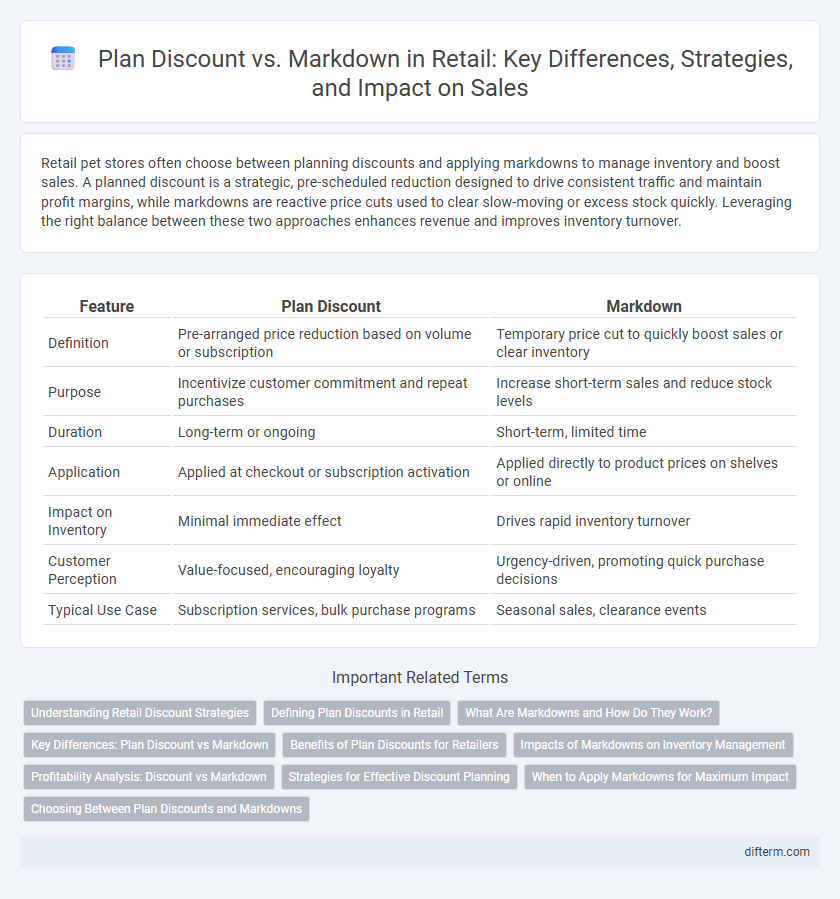Retail pet stores often choose between planning discounts and applying markdowns to manage inventory and boost sales. A planned discount is a strategic, pre-scheduled reduction designed to drive consistent traffic and maintain profit margins, while markdowns are reactive price cuts used to clear slow-moving or excess stock quickly. Leveraging the right balance between these two approaches enhances revenue and improves inventory turnover.
Table of Comparison
| Feature | Plan Discount | Markdown |
|---|---|---|
| Definition | Pre-arranged price reduction based on volume or subscription | Temporary price cut to quickly boost sales or clear inventory |
| Purpose | Incentivize customer commitment and repeat purchases | Increase short-term sales and reduce stock levels |
| Duration | Long-term or ongoing | Short-term, limited time |
| Application | Applied at checkout or subscription activation | Applied directly to product prices on shelves or online |
| Impact on Inventory | Minimal immediate effect | Drives rapid inventory turnover |
| Customer Perception | Value-focused, encouraging loyalty | Urgency-driven, promoting quick purchase decisions |
| Typical Use Case | Subscription services, bulk purchase programs | Seasonal sales, clearance events |
Understanding Retail Discount Strategies
Retail discount strategies differentiate between planned discounts, which are premeditated price reductions aimed at clearing seasonal inventory or boosting sales during specific periods, and markdowns, which are reactive adjustments based on market demand or overstock situations. Planned discounts often align with promotional calendars and budgeting forecasts, ensuring inventory turnover aligns with financial goals, while markdowns provide flexibility to address unsold merchandise and enhance cash flow. Understanding these distinctions helps retailers optimize profit margins and maintain competitive positioning in dynamic market conditions.
Defining Plan Discounts in Retail
Plan discounts in retail refer to predetermined reductions applied during promotional campaigns, designed to encourage bulk purchases or incentivize specific customer behaviors. These discounts are strategically calculated based on sales targets and inventory levels to optimize profit margins while maintaining competitive pricing. Unlike markdowns, which are reactive price cuts to clear excess stock, plan discounts are proactive pricing strategies integrated into merchandising plans.
What Are Markdowns and How Do They Work?
Markdowns are deliberate price reductions on retail products aimed at accelerating inventory turnover and clearing out slow-moving or excess stock. These price adjustments impact profit margins but help retailers maintain cash flow and make room for new merchandise. By analyzing sales data and inventory levels, retailers strategically apply markdowns to optimize stock levels and enhance overall revenue performance.
Key Differences: Plan Discount vs Markdown
Plan discounts are premeditated reductions applied during the pricing strategy phase, designed to influence consumer buying behavior and maintain profit margins. Markdowns occur reactively, adjusting prices to clear excess inventory or respond to market demand fluctuations. The key difference lies in timing and intent: plan discounts are proactive and strategic, while markdowns are reactive and tactical adjustments.
Benefits of Plan Discounts for Retailers
Plan discounts enable retailers to strategically manage inventory by offering targeted price reductions that attract specific customer segments, increasing sales volume and improving cash flow. These discounts help maintain product value perception while reducing the risk of overstock, supporting better profit margins compared to unplanned markdowns. Implementing plan discounts fosters customer loyalty through predictable promotions, enhancing long-term brand engagement and driving repeat purchases.
Impacts of Markdowns on Inventory Management
Markdowns significantly influence inventory management by accelerating the clearance of slow-moving stock, reducing carrying costs and freeing up retail space for new merchandise. Effective markdown strategies help balance inventory levels, minimizing overstock and obsolescence risks while optimizing cash flow. The timing and depth of markdowns directly impact sales velocity, inventory turnover rates, and overall profitability in retail operations.
Profitability Analysis: Discount vs Markdown
Plan discounts strategically balance customer incentives with profit margins, ensuring sustained revenue growth, while markdowns, typically reactive price reductions, directly impact gross profit by lowering selling prices to clear inventory. Profitability analysis reveals that planned discounts can enhance sales volume and customer loyalty without severely compromising profit, whereas excessive or poorly timed markdowns reduce gross margins and risk inventory devaluation. Retailers optimize profitability by analyzing sales data and price elasticity to determine the ideal mix of planned discounts versus markdowns, maximizing revenue while controlling costs.
Strategies for Effective Discount Planning
Effective discount planning in retail hinges on balancing planned discounts and markdown strategies to optimize inventory turnover and profit margins. Planned discounts are premeditated, targeting specific products and periods to stimulate demand, whereas markdowns react to unsold inventory and changing market conditions. Retailers employing data-driven analytics can tailor discount plans to customer behavior, seasonality, and competitive pricing, ensuring maximized revenue without eroding brand value.
When to Apply Markdowns for Maximum Impact
Applying markdowns strategically during peak shopping periods, such as holiday seasons or end-of-season clearances, maximizes sales velocity and inventory turnover. Retailers should analyze sales data and customer demand trends to pinpoint slow-moving products, making targeted markdowns more effective in freeing up shelf space. Timing markdowns just before new product launches or promotional events can boost customer interest and improve overall profitability.
Choosing Between Plan Discounts and Markdowns
Choosing between plan discounts and markdowns hinges on balancing inventory turnover and profit margins in retail. Plan discounts are premeditated price reductions designed to stimulate early sales without eroding brand value, while markdowns are reactive adjustments used to clear excess or slow-moving stock. Retailers optimize profitability by analyzing sales trends, inventory levels, and customer price sensitivity to determine the most effective strategy.
Plan Discount vs Markdown Infographic

 difterm.com
difterm.com